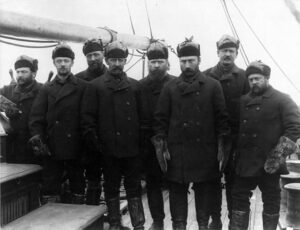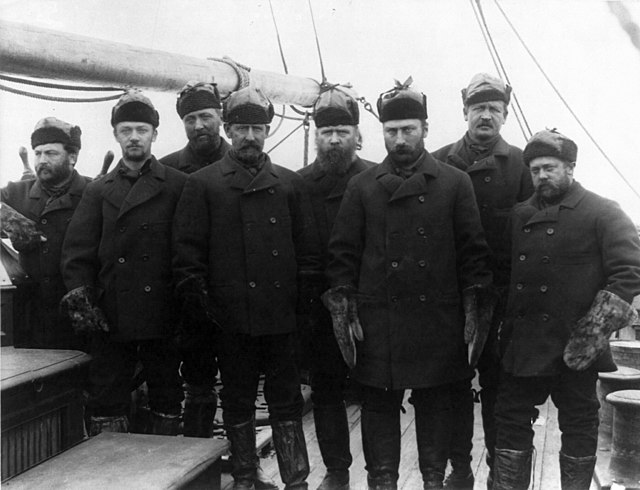
In 1881, Cdr. Winfield Scott Schley was at the Charlestown Navy Yard reading a newspaper article about the US Army Signal Corps’ ambitious Lady Franklin Bay Expedition. He considered it unusual— even foolhardy—that the US Navy wasn’t in charge of the enterprise, which involved steaming, sailing, and navigating 1800 nautical miles through some of the most treacherous, ice-choked waters from Newfoundland all the way to the northernmost coasts of Canada and Greenland to conduct polar research. Instead, it was an Army affair.
On finishing the article, Cdr. Schley quipped to some of his friends: “This means that some Navy officer will have to go up there and bring them back.” As fate would have it, three years later, the man that the secretary of the navy and the president of the United States wanted for the job was him.
***
The Lady Franklin Bay Expedition—which would come to be known as the Greely Expedition—was under the aegis of the United States Army, as part of the first International Polar Year establishing a dozen circumpolar research stations to conduct intensive meteorological studies in the high Arctic.
In the summer of 1881, the US Army sent Lt. Adolphus Greely and a crew of twenty-four scientists to Lady Franklin Bay, where they built Fort Conger on the banks of a fjord on northern Ellesmere Island, Canada, directly across the Hall Basin from northwestern Greenland. After two years, Greely and his men had achieved many of their goals, including attaining Farthest North—the polar holy grail. But as they scanned and glassed Lady Franklin Bay, no scheduled resupply ships came.
Based on prior written orders, should no relief ships arrive after the second year, Greely was to retreat with his men by steam launch and rowboats some 250-miles south to Cape Sabine, where they were to await resupply, and seek food caches presumably deposited there by the Proteus. But they found no provisions. Unbeknownst to Greely, the two-hundred-foot-long, 467-ton steamer Proteus had been crushed by ice trying to reach them, and it now lay at the bottom of the freezing waters of the Smith Sound, along with all the food earmarked for his expeditionary force.
As a result, by autumn of 1884, Greely and his bedraggled crew were clinging for life at a crude outpost near Cape Sabine, dangerously low on food and facing a long, cold, dark Arctic winter.
With no news of Greely’s whereabouts and national public outcry for the government to do something for the missing men, Secretary of the Navy William E. Chandler purchased two Arctic-worthy ships—the Bear and the Thetis. Now he needed the right man to lead the rescue operation to Cape Sabine.
After considering a long list of possible candidates, Secretary Chandler focused on Commander Schley, a U.S. Naval Academy graduate and Civil War veteran, where he’d served on the frigate Potomac and the gunboat Winona with the Western Gulf Squadron. He had later distinguished himself as a combat leader in 1871 while on assignment in Korea with the Asiatic Station. He had also served in Europe, on Africa’s west coast, and in the South Atlantic as far as Brazil, aboard the USS Essex.
By the winter of 1884, Schley, a stern man of short stature, was forty-five years old, with a long, pointy chin patch and a receding hairline. Secretary Chandler dismissed Schley’s age; he was impressed by the commander’s wealth of experience, his organizational skills and attention to detail, and by his reputation of being bold and daring. Chandler offered Schley the appointment, noting that he, President Grover Cleveland, and Secretary of War Robert Todd Lincoln (eldest son of President Abraham Lincoln) were all counting on him.
So was the entire nation.
Schley proudly accepted the weighty responsibility and got to work outfitting the Bear and Thetis (and two other tenders/support ships) at St. John’s, Newfoundland. Schley purchased thousands of pounds of food, hanging beef high in the rigging, out of reach of the sled dogs, where it would freeze and be preserved in the frigid temperatures as they headed north. Schley earmarked a considerable portion of the beef exclusively for Lieutenant Greely and his party, for he understood that when found, they would be in dire condition.
Schley also issued each officer and sailor a personal kit for use should the ships be crushed by ice, including rubber knapsacks containing extra clothing and footgear in the event of weeks or even months on the ice. Two months provisions were stowed on each ship’s deck for quick access in case of abandonment. There would be no repeat of the Proteus disaster.
The Bear left St. John’s on May 4, 1884, planning to rendezvous with Schley and the Thetis at Upernavik, Greenland, near the end of the month. By May 24, Commander Schley was gripping the rope ladder and climbing the 130 feet to the crow’s nest of the Thetis. Biting wind cut through his thick woolen topcoat and blistered face as he ascended. Once inside the barrel, he rested his telescope on the iron edge and fixed his gaze on the diabolical ice pack of the upper Davis Strait, just below Melville Bay. He could see ten to fifteen miles ahead, noting nothing but ice fields and snaking leads stretching before him in wide panorama.
Schley pondered the labyrinthine pack. For just this situation he had brought along explosives to assist in ramming through ice, and to blow up smaller floes to create navigable leads. He had on board many “torpedoes,” five-pound explosives contained in tin cylinders, rigged with electric connections and fuses. His plan was to use ice augers to drill holes in the ice ahead of the ships, place the torpedoes, and detonate them. Commander Schley intended, if it came to it, to explode his way to Greely. He wasn’t sure it would work, but he was damned sure going to try.
Nearly a month later, on June 22, 1884, Schley had indeed navigated his rescue armada to a rocky, wind-battered coastline off of Cape Sabine. Schley blew three long signal blasts of the Thetis’s whistle, then sent rescuers in rowboats ashore. Scrambling up and over a steep and flinty escarpment, the rescuers encountered a dilapidated tent blown down by gales. Moments later, a soot-darkened man with a long, matted beard, his clothes dirty and tattered, crawled through the tent door. The man rose to his knees and with trembling hands put put on a pair of oval-shaped spectacles. His once brilliant eyes were sunken and bloodshot. It was Adolphus Greely.
With his voice just a thin thread of a whisper, stammering and breaking with emotion, Greely husked, “Seven of us left. Here we are, dying like men. Did what I came to do—beat the record [of Farthest North].” Then he crumpled to the hard ground, too exhausted to say more.
Commander Winfield Scott Schley had also done what he came to do: rescue what was left of the Greely Expedition.
Schley would eventually achieve the rank of Rear Admiral in the United States Navy, and after a storied career—including service in the Spanish-American War and the Battle of Santiago—he died at the age of 72 and was buried with full military honors at Arlington National Cemetery on October 5, 1911.
And he will always be remembered as the Navy man who saved Greely. *
**Source and quotes drawn from Buddy Levy’s Labyrinth of Ice: The Triumphant and
Tragic Greely Polar Expedition (St. Martin’s Press, 2019).

